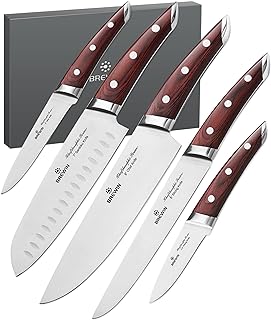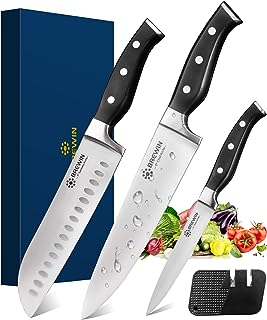5 important factors worth considering when looking for the best chef knife
When it comes to the most important tool in any kitchen, the chef knife stands out. It can either make your cooking better or leave you frustrated with poor performance. With so many options to choose from, it’s important to pay attention to factors like blade material, handle design, blade shape, and overall balance. These elements work together to determine how effective and long-lasting the knife will be in your kitchen. Exploring the world of chef knives requires careful thought and attention to detail, as each feature plays a significant role in shaping your cooking skills and experiences.
See our guide to the best chef knife.
Blade material
When choosing a chef’s knife, the type of blade material is really important. High-carbon stainless steel is often seen as the best choice because it stays sharp and doesn’t rust easily. This type of blade is durable and keeps its sharpness even with lots of use in the kitchen. It’s also easy to take care of, which is great for both professional chefs and home cooks who want efficiency and accuracy in cooking.
On the other hand, some people prefer carbon steel blades because they are incredibly sharp and stay sharp for a long time. Carbon steel blades need more maintenance to prevent rust and discoloration, but many experienced chefs like them because they can achieve very sharp edges for precise cutting. The unique discoloration that forms on a carbon steel blade over time is seen as a symbol of the knife’s journey and is respected by many cooking enthusiasts.
Ultimately, the choice between high-carbon stainless steel and carbon steel comes down to personal preference and how much maintenance you’re willing to do. Both materials have their own advantages that can enhance the cooking experience.
Blade length
Choosing the right chef knife is important, especially when it comes to the length of the blade. A longer blade can handle a variety of tasks like chopping, slicing, and dicing different ingredients. It makes preparing meals easier and safer by giving you more reach and control. On the other hand, a shorter blade is better for detailed and delicate tasks. It offers more precision for small cuts and intricate techniques. The decision between a longer or shorter blade length depends on what feels best for you and what you need in the kitchen.
Handle material
Choosing the right handle material for a chef’s knife is an important decision that is often overlooked. While the blade gets a lot of attention, the handle is actually very important because it affects how comfortable and in control you feel when using the knife. Picking a high-quality handle material like micarta, G-10, or pakka wood can improve your cutting skills and make it easier to use the knife for long periods of time in the kitchen. These materials are strong, resistant to moisture, and designed to be comfortable to hold, which can make a big difference in how well you cook.
By getting a chef’s knife with the right handle material, you are not just getting a tool for the kitchen; you are giving yourself the ability to cook with skill and efficiency.
The handle material of a chef’s knife can also affect how the knife looks and how it feels to you personally. Choosing a handle material that matches your style can make cooking feel more enjoyable and unique. Whether you like the classic look of wooden handles or the modern style of composite materials, the handle material you pick can show off your cooking personality and help you feel connected to your knife. When you understand how important handle materials are for chef’s knives, you are not just thinking practically; you are showing that you value the care and passion that goes into every dish you create.
Weight and balance
When looking at chef knives, it’s important to think about how heavy and balanced they are. These two things are really important for how well the knife works when a chef is using it. The weight of a knife affects how easy it is to use and how well it can cut different ingredients. A well-balanced chef knife helps chefs make precise cuts smoothly. It has the right amount of weight for stability and the right amount of agility for quick, smooth cuts. This makes cooking more like an art form, with everything working together perfectly.
When picking a chef knife, it’s not just about how sharp the blade is. It’s also about how the weight and balance of the handle feel. A knife that feels heavy or unbalanced can make a chef tired and uncomfortable, which makes cooking less fun. But a well-balanced knife that feels like an extension of your arm makes cooking easier and more enjoyable. The way weight and balance work together in a chef knife is more than just about how well it works. It’s about how the knife connects the chef to their cooking, turning the kitchen into a place for great food. The balance in a chef knife is what makes it special – it’s a mix of skill and art that goes beyond just being a tool, becoming a necessary partner in the cooking journey.
Edge retention and sharpness
When choosing a chef knife, it’s important to think about how long it can keep its sharpness. This is key to a good kitchen knife because it determines how well it can slice and dice ingredients accurately. A knife that loses its sharpness easily can make cooking tasks frustrating. On the other hand, a knife with great edge retention will be a reliable companion in the kitchen, effortlessly slicing through ingredients every time.
When it comes to chef knives, focusing on edge retention and sharpness is crucial. A high-quality knife with good edge retention can enhance your cooking experience by providing consistent performance and durability. While there are many factors that make a knife great, the ability to keep a sharp edge is a standout feature that sets exceptional knives apart. Ultimately, a chef knife that excels in edge retention and sharpness can change the way you cook, making food preparation easier and enhancing your skills and enjoyment in the kitchen.
Conclusion
The chef knife is a timeless tool that represents precision and skill, enhancing the cooking experience for anyone who uses it. Whether slicing a tomato or chopping herbs, the chef knife combines art and function. Its long history in the culinary world shows how important it is in the kitchen, becoming a trusted tool for chefs and home cooks. Want more info on heated gloves for arthritis, check the best heated gloves for arthritis.

